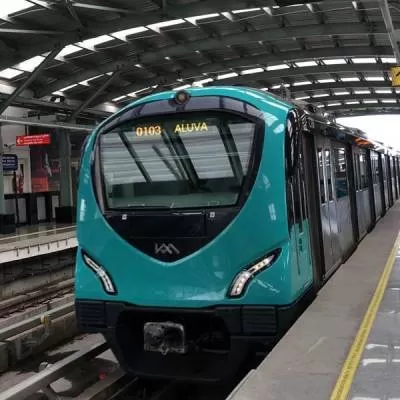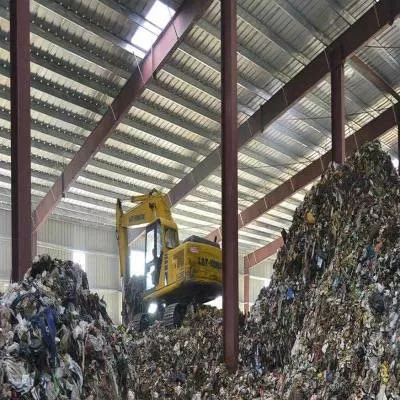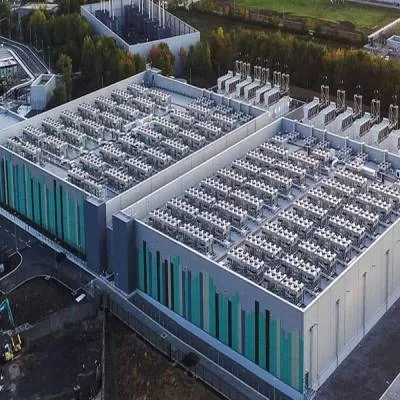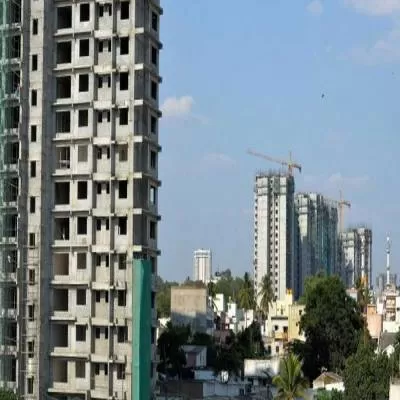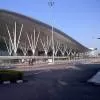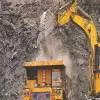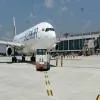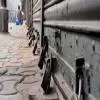- Home
- Real Estate
- Saving Lives at Site
Saving Lives at Site
Engineer Jagvir Goyal tells us about equipment for safety in construction.
Construction work by nature entails danger. The complexity of work, mounting pressures to achieve targets and lack of awareness among labour all make it impossible to eliminate accidents during construction. That's why, all around the world, more people die at construction sites than in road accidents. Yet it is possible to minimise accidents with the use of safe equipment and by taking effective steps based on actual experience.
Need for awareness
More and more people are becoming aware of the importance of safety in the construction sector. In October 2004, the biggest ever campaign was launched in Europe to make engineers, builders and workers aware of this imperative. Electrocution, falling from heights and getting crushed under machinery were noted to be the three major causes of accidental deaths during construction. In India, the scene is somewhat different. The Indian construction industry is still highly labour-intensive. Until a few years ago, the use of machinery was considered by builders as more expensive than employing labour, which was available at cheap rates owing to unemployment and poverty. Now things are changing and more machinery is being used at sites. Still, the causes behind most construction accidents in India are failure of scaffolds, falls from heights and getting buried in excavated pits owing to the collapse of improperly cut earth walls.
Safety steps
Here are some safety steps based on actual experience in the field:
1. Ensure that all scaffolds are safe. Get them designed rather than leaving them to the foreman's experience. Decide the spacing of verticals, horizontals and braces carefully. Prefer steel scaffolds to wooden scaffolds.
2. Make safe access arrangements. Wherever motor-run passenger cages are used to transfer people to the top of buildings, take special care of wire ropes and hoists. Maintain them well so they do not fail.
3. Wherever the height of the building crosses 30 m, provide temporary lightening protection arrangement. Also provide temporary aviation warning light arrangement to send a signal to aircraft flying overhead. Allow these to remain in position till permanent arrangements are provided in the buildings.
4. Take adequate measures against fire. Keep gas cylinders upright. Train some workers in the use of fire extinguishers and other equipment.
5. In multi-storied buildings, make the use of safety helmets and safety belts compulsory and don't allow workers to enter the work area unless they wear them.
6. Provide warning signs around the construction area that scream (as appropriate): Men working overhead! Danger, winch area ahead! Blasting in progress!
7. Always keep a first-aid box at site and keep it updated. Always keep a standby vehicle at site to rush injured workers to hospital. Those few moments saved are always precious.
8. Always insulate all electric tools and train workers to use insulating gloves and tools.
9. Provide sufficient illumination of work area if work is on at night. Provide emergency lights to avoid panic and stampedes during power failures.
10. Always stack the excavated earth away from the pit so it doesn't make the sides collapse and bury workers inside. Keep the excavated sides sloping not vertical.
11. Create safety cells at sites whose exclusive job is to ensure implementation of safety steps and make site staff aware of the importance of safety. This cell should observe safety weeks and institute safety awards to encourage workers.
12. Evolve a construction safety manual for sites. It will save you the trouble of referring to various codes and guidelines lying scattered in different volumes.
13. Organisations should enforce yearly safety audit of their sites by internal and external agencies.
Equipment for safety
The use of safety equipment plays a significant role in avoiding accidents and converting fatal accidents into non-fatal accidents. Every engineer should, therefore, be fully conversant with safety equipment. However, it has been noted that only scattered information is available on this topic. Our endeavour is to compile all this information here at one place for engineers to keep handy and use when required.
Scaffolding pipes, clamps, joint pins and base plates
The most important factor in the construction of structures is to have safe scaffolds. In high-rise structures, this assumes even more significance. As a high-rise structure progresses skywards, work-enabling scaffolding is raised inside and around it to enable workers to fix formwork, bind reinforcement, lay concrete and carry out other miscellaneous jobs at the top level. Most accidents tend to occur owing to the failure of this scaffolding, leading to a number of casualties besides complete stoppage of work. Here are some lessons learnt from scaffolding failures around the world:
1. For high-rise structures, scaffolding should be designed by the engineer instead of leaving it to the foreman's experience. During the construction of a 220-m-high RCC chimney, the spacing of the verticals below the beams was initially kept as 900 mm c/c. It was decided to check the actual load per vertical. The designer found that the load per vertical exceeded its load-carrying capacity and spacing had to be reduced to 600 mm c/c. As the height of verticals increases continuously in high-rise structures, it is safer to go for proper design of scaffolding and provide the spacing of verticals, horizontals and bracings accordingly.
2. Vertical and load-bearing heavy-duty scaffolding pipes need to be segregated from horizontal and diagonal bracing pipes and marked with a red band for easy identification. These pipes should have perfect ends and no distortions or dents for full transfer of the load to the ground. The site supervisor should ensure that only such pipes are used as 'verticals'.
3. Separate stacks of load bearing and non-load bearing pipes should be maintained at site.
4. The clamps used for upward extension of pipes and fixing horizontal and diagonal pipes to verticals should be checked in advance, made functional and lubricated well. Defective clamps should be rejected or sent for repair. Workers do not have the patience to check the workability of clamps and fix whatever clamp comes to their hands. Defective clamps do not allow full transfer of load at joints.
5. Sufficient clamps should always be made available at site. A shortage of clamps is a common occurrence as the number of clamps required runs into lakhs. During studies, it was revealed that a scaffolding tower inside a cooling tower collapsed when it had reached a height of 90 m leading to a number of casualties. The reason was shortage of clamps. The workers deployed on the scaffolding tower were working on a contract basis. As enough clamps were not available, they kept removing clamps from the structure below and used them to raise the height without understanding the consequences. Ultimately, the pipes below buckled, leading to the collapse of the tower.
6. Spacing of vertical pipes needs to be decided depending upon the load to be transferred to the ground. Spacing of horizontal pipes should not be more than 1.5 m. Diagonal braces should be provided in horizontal and vertical planes.
7. Base plates should be provided below verticals to allow sufficient bearing area for each vertical. The couplers or joint pins used for connection of vertical to vertical should be carefully designed for full transfer of load.
Access equipment
The use of safe access equipment to reach the top and working deck of a structure is another important measure to prevent accidents. In general, an access tower carrying ladders to the top is provided and raised along with the gained height of a structure. In addition, a temporary cage operated by a friction hoist is provided to allow quick access to engineers and supervisory staff. During the construction of a 220-m-high RCC chimney, the temporary cage fell down from a height of 20 m to the platform at 9-m level, leading to multiple injuries to the supervisory staff being carried in it. The cause was snapping of strands of the wire rope used in the friction hoist besides overloading of the cage. New wire ropes of sufficient diameter were then used and an overload timer was fixed in the cage to avoid a mishap in future.
Self-propelled aerial work platform equipment
Running of the hoist-operated temporary cage in an extended section of the access tower produces a lot of vibrations. In case such an arrangement is made, the tower should be designed and strengthened accordingly. Otherwise, for a height of 20 m or less, self-propelled aerial work platform equipment can be used. This can be used even in most restricted areas of work. It has articulated booms that can move a platform of 1 tonne capacity. Escorts equipment has a chassis width of only 1.2 m to 1.75 m and is fitted with all protective devices.
Friction hoists
Friction hoists used for operating the temporary cage should be well maintained to avoid failure. The magnetic brake should be checked every day. Preferably, a double-drum winch with double-wire rope, each a minimum of 16 mm in diameter, should be used. Wire ropes should be checked and lubricated at regular intervals. In case any broken strands are noted, the rope should be replaced immediately.
Passenger cages
The passenger carrying cage should always be provided with an overload timer. In addition, it should have provision for slow but smooth lowering of cage under gravity, for use in case of power failure. As the height of the structure and the access tower is raised with progress of work, arrangement should be made at the hanging point of the cage to stop it as soon as it reaches maximum height by providing an upper limit switch.
Safety equipment
Important safety equipment includes the following:
1. Safety helmets: Safety helmets should always be ISI-marked. All workers should compulsorily be made to wear safety helmets irrespective of working level.
2. Safety belts: All workers deployed at higher elevations should be made to wear safety belts to avoid falls.
3. Protective gloves, shoes and aprons: Workers handling electric equipment and chemicals should be made to wear protective gloves, shoes and aprons.
4. Ear plugs: These should be provided to workers deployed in high noise level locations.
5. Face masks: Face masks or nose filters should be worn by workers in areas where noxious gases are relea-sed by chimneys or chemical plants. Respiratory equipment should also be kept available for use when required.
6. Safety goggles: Safety goggles and flash shields should be used by workers engaged in welding.
7. Breathing air hoods: These should be provided to workers doing sand blasting or spray painting.
8. Reflective jackets and traffic cones: These should be provided to workers engaged on highways to protect themselves from fast-moving traffic.
9. Head lamps and smoke cutter lamps: These should be provided to workers in mines, smoke-raising areas, coal-handling plants, tunnels and other sub-ground works.
10. First-aid box: This should always be provided at site and on all working levels in high-rise structures.
11. Emergency lights: These should always be kept in enclosed areas and on all working levels to avoid panic among workers during power failures.
12. Safety mesh: At higher elevations, when working decks are to be created on the outer surface of the structure, a nylon mesh sho-uld be provided covering the outer hanging scaffolds and working decks. This proves very effective in protecting workers and preventing goods from falling down. A similar mesh should be provided on the inner surface too if workers are engaged there.
Aviation warning light equipment
When the height of a structure crosses 30 m, it requires a sufficient number of aviation warning lights with a minimum intensity of 100 lux and red colour to provide a clear signal to aircrafts flying overhead. The arrangement must continue till the provision of permanent aviation warning lights on the structure.
Fire-fighting equipment
Every construction site must be equipped with complete fire-fighting equipment. Fire extinguishers that are not expired and are fully functional should be available. Sand buckets should be kept ready. Fire-fighting goggles should be kept for use whenever a fire breaks out. Some workers should be trained to operate the fire-fighting equipment. Water mist equipment should also be kept and fire-fighting hydrants should be created to draw water when required.
Safety steps for handling equipment
Here are some key steps to be considered while handling equipment:
1. All electric tools should be properly insulated.
2. All winches and hoists should be provided with magnetic brakes for automatic operation on failure of electricity.
3. No metallic ladders should be used when high-voltage electric wires are passing overhead.
4. All compressed gas cylinders should be stored only in an upright position with valve caps in place.
5. All equipment should be provided with proper earthing.
6. No electric tools should be used while standing in water.
7. Splicing of wire ropes should be avoided in critical areas.
8. Only skilled workers, well conversant with the plant and machinery, should be allowed to handle equipment.
9. A proper railing should be provided around all working platforms at higher levels.
10. Any spill over of oil or grease on ladders, stairs or landings should be cleaned at once.
11. The height of ladders should be restricted. Ladders that are too long should not be allowed and intermediate landing platforms should be provided to give relief to workers going up.
12. Proper bearing should be provided to planks and battens used in temporary platforms. No overhangs should be permitted.
13. Full arrangements for storage and handling of explosives, radioactive elements and chemicals should be made where necessary.
Engineer Jagvir Goyal tells us about equipment for safety in construction. Construction work by nature entails danger. The complexity of work, mounting pressures to achieve targets and lack of awareness among labour all make it impossible to eliminate accidents during construction. That's why, all around the world, more people die at construction sites than in road accidents. Yet it is possible to minimise accidents with the use of safe equipment and by taking effective steps based on actual experience. Need for awareness More and more people are becoming aware of the importance of safety in the construction sector. In October 2004, the biggest ever campaign was launched in Europe to make engineers, builders and workers aware of this imperative. Electrocution, falling from heights and getting crushed under machinery were noted to be the three major causes of accidental deaths during construction. In India, the scene is somewhat different. The Indian construction industry is still highly labour-intensive. Until a few years ago, the use of machinery was considered by builders as more expensive than employing labour, which was available at cheap rates owing to unemployment and poverty. Now things are changing and more machinery is being used at sites. Still, the causes behind most construction accidents in India are failure of scaffolds, falls from heights and getting buried in excavated pits owing to the collapse of improperly cut earth walls. Safety steps Here are some safety steps based on actual experience in the field: 1. Ensure that all scaffolds are safe. Get them designed rather than leaving them to the foreman's experience. Decide the spacing of verticals, horizontals and braces carefully. Prefer steel scaffolds to wooden scaffolds.2. Make safe access arrangements. Wherever motor-run passenger cages are used to transfer people to the top of buildings, take special care of wire ropes and hoists. Maintain them well so they do not fail.3. Wherever the height of the building crosses 30 m, provide temporary lightening protection arrangement. Also provide temporary aviation warning light arrangement to send a signal to aircraft flying overhead. Allow these to remain in position till permanent arrangements are provided in the buildings.4. Take adequate measures against fire. Keep gas cylinders upright. Train some workers in the use of fire extinguishers and other equipment.5. In multi-storied buildings, make the use of safety helmets and safety belts compulsory and don't allow workers to enter the work area unless they wear them.6. Provide warning signs around the construction area that scream (as appropriate): Men working overhead! Danger, winch area ahead! Blasting in progress!7. Always keep a first-aid box at site and keep it updated. Always keep a standby vehicle at site to rush injured workers to hospital. Those few moments saved are always precious.8. Always insulate all electric tools and train workers to use insulating gloves and tools.9. Provide sufficient illumination of work area if work is on at night. Provide emergency lights to avoid panic and stampedes during power failures.10. Always stack the excavated earth away from the pit so it doesn't make the sides collapse and bury workers inside. Keep the excavated sides sloping not vertical.11. Create safety cells at sites whose exclusive job is to ensure implementation of safety steps and make site staff aware of the importance of safety. This cell should observe safety weeks and institute safety awards to encourage workers.12. Evolve a construction safety manual for sites. It will save you the trouble of referring to various codes and guidelines lying scattered in different volumes.13. Organisations should enforce yearly safety audit of their sites by internal and external agencies. Equipment for safety The use of safety equipment plays a significant role in avoiding accidents and converting fatal accidents into non-fatal accidents. Every engineer should, therefore, be fully conversant with safety equipment. However, it has been noted that only scattered information is available on this topic. Our endeavour is to compile all this information here at one place for engineers to keep handy and use when required. Scaffolding pipes, clamps, joint pins and base plates The most important factor in the construction of structures is to have safe scaffolds. In high-rise structures, this assumes even more significance. As a high-rise structure progresses skywards, work-enabling scaffolding is raised inside and around it to enable workers to fix formwork, bind reinforcement, lay concrete and carry out other miscellaneous jobs at the top level. Most accidents tend to occur owing to the failure of this scaffolding, leading to a number of casualties besides complete stoppage of work. Here are some lessons learnt from scaffolding failures around the world: 1. For high-rise structures, scaffolding should be designed by the engineer instead of leaving it to the foreman's experience. During the construction of a 220-m-high RCC chimney, the spacing of the verticals below the beams was initially kept as 900 mm c/c. It was decided to check the actual load per vertical. The designer found that the load per vertical exceeded its load-carrying capacity and spacing had to be reduced to 600 mm c/c. As the height of verticals increases continuously in high-rise structures, it is safer to go for proper design of scaffolding and provide the spacing of verticals, horizontals and bracings accordingly.2. Vertical and load-bearing heavy-duty scaffolding pipes need to be segregated from horizontal and diagonal bracing pipes and marked with a red band for easy identification. These pipes should have perfect ends and no distortions or dents for full transfer of the load to the ground. The site supervisor should ensure that only such pipes are used as 'verticals'.3. Separate stacks of load bearing and non-load bearing pipes should be maintained at site.4. The clamps used for upward extension of pipes and fixing horizontal and diagonal pipes to verticals should be checked in advance, made functional and lubricated well. Defective clamps should be rejected or sent for repair. Workers do not have the patience to check the workability of clamps and fix whatever clamp comes to their hands. Defective clamps do not allow full transfer of load at joints.5. Sufficient clamps should always be made available at site. A shortage of clamps is a common occurrence as the number of clamps required runs into lakhs. During studies, it was revealed that a scaffolding tower inside a cooling tower collapsed when it had reached a height of 90 m leading to a number of casualties. The reason was shortage of clamps. The workers deployed on the scaffolding tower were working on a contract basis. As enough clamps were not available, they kept removing clamps from the structure below and used them to raise the height without understanding the consequences. Ultimately, the pipes below buckled, leading to the collapse of the tower.6. Spacing of vertical pipes needs to be decided depending upon the load to be transferred to the ground. Spacing of horizontal pipes should not be more than 1.5 m. Diagonal braces should be provided in horizontal and vertical planes.7. Base plates should be provided below verticals to allow sufficient bearing area for each vertical. The couplers or joint pins used for connection of vertical to vertical should be carefully designed for full transfer of load. Access equipment The use of safe access equipment to reach the top and working deck of a structure is another important measure to prevent accidents. In general, an access tower carrying ladders to the top is provided and raised along with the gained height of a structure. In addition, a temporary cage operated by a friction hoist is provided to allow quick access to engineers and supervisory staff. During the construction of a 220-m-high RCC chimney, the temporary cage fell down from a height of 20 m to the platform at 9-m level, leading to multiple injuries to the supervisory staff being carried in it. The cause was snapping of strands of the wire rope used in the friction hoist besides overloading of the cage. New wire ropes of sufficient diameter were then used and an overload timer was fixed in the cage to avoid a mishap in future. Self-propelled aerial work platform equipment Running of the hoist-operated temporary cage in an extended section of the access tower produces a lot of vibrations. In case such an arrangement is made, the tower should be designed and strengthened accordingly. Otherwise, for a height of 20 m or less, self-propelled aerial work platform equipment can be used. This can be used even in most restricted areas of work. It has articulated booms that can move a platform of 1 tonne capacity. Escorts equipment has a chassis width of only 1.2 m to 1.75 m and is fitted with all protective devices. Friction hoists Friction hoists used for operating the temporary cage should be well maintained to avoid failure. The magnetic brake should be checked every day. Preferably, a double-drum winch with double-wire rope, each a minimum of 16 mm in diameter, should be used. Wire ropes should be checked and lubricated at regular intervals. In case any broken strands are noted, the rope should be replaced immediately. Passenger cages The passenger carrying cage should always be provided with an overload timer. In addition, it should have provision for slow but smooth lowering of cage under gravity, for use in case of power failure. As the height of the structure and the access tower is raised with progress of work, arrangement should be made at the hanging point of the cage to stop it as soon as it reaches maximum height by providing an upper limit switch. Safety equipment Important safety equipment includes the following: 1. Safety helmets: Safety helmets should always be ISI-marked. All workers should compulsorily be made to wear safety helmets irrespective of working level.2. Safety belts: All workers deployed at higher elevations should be made to wear safety belts to avoid falls.3. Protective gloves, shoes and aprons: Workers handling electric equipment and chemicals should be made to wear protective gloves, shoes and aprons.4. Ear plugs: These should be provided to workers deployed in high noise level locations.5. Face masks: Face masks or nose filters should be worn by workers in areas where noxious gases are relea-sed by chimneys or chemical plants. Respiratory equipment should also be kept available for use when required.6. Safety goggles: Safety goggles and flash shields should be used by workers engaged in welding.7. Breathing air hoods: These should be provided to workers doing sand blasting or spray painting.8. Reflective jackets and traffic cones: These should be provided to workers engaged on highways to protect themselves from fast-moving traffic.9. Head lamps and smoke cutter lamps: These should be provided to workers in mines, smoke-raising areas, coal-handling plants, tunnels and other sub-ground works.10. First-aid box: This should always be provided at site and on all working levels in high-rise structures.11. Emergency lights: These should always be kept in enclosed areas and on all working levels to avoid panic among workers during power failures.12. Safety mesh: At higher elevations, when working decks are to be created on the outer surface of the structure, a nylon mesh sho-uld be provided covering the outer hanging scaffolds and working decks. This proves very effective in protecting workers and preventing goods from falling down. A similar mesh should be provided on the inner surface too if workers are engaged there. Aviation warning light equipment When the height of a structure crosses 30 m, it requires a sufficient number of aviation warning lights with a minimum intensity of 100 lux and red colour to provide a clear signal to aircrafts flying overhead. The arrangement must continue till the provision of permanent aviation warning lights on the structure. Fire-fighting equipment Every construction site must be equipped with complete fire-fighting equipment. Fire extinguishers that are not expired and are fully functional should be available. Sand buckets should be kept ready. Fire-fighting goggles should be kept for use whenever a fire breaks out. Some workers should be trained to operate the fire-fighting equipment. Water mist equipment should also be kept and fire-fighting hydrants should be created to draw water when required. Safety steps for handling equipment Here are some key steps to be considered while handling equipment: 1. All electric tools should be properly insulated.2. All winches and hoists should be provided with magnetic brakes for automatic operation on failure of electricity.3. No metallic ladders should be used when high-voltage electric wires are passing overhead.4. All compressed gas cylinders should be stored only in an upright position with valve caps in place.5. All equipment should be provided with proper earthing.6. No electric tools should be used while standing in water.7. Splicing of wire ropes should be avoided in critical areas.8. Only skilled workers, well conversant with the plant and machinery, should be allowed to handle equipment.9. A proper railing should be provided around all working platforms at higher levels.10. Any spill over of oil or grease on ladders, stairs or landings should be cleaned at once.11. The height of ladders should be restricted. Ladders that are too long should not be allowed and intermediate landing platforms should be provided to give relief to workers going up.12. Proper bearing should be provided to planks and battens used in temporary platforms. No overhangs should be permitted.13. Full arrangements for storage and handling of explosives, radioactive elements and chemicals should be made where necessary.


